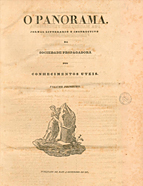

................................
What structure, then, did the editors implement to ensure the newspaper’s enduring success? As noted, Herculano had already outlined his understanding of the different types of readers. The solution was relatively straightforward: to divide each issue into two distinct sections while maintaining the existing structure but reformulating its content. The first section contained longer articles that delved deeply into topics such as natural sciences, history, geography, topography, monuments, economics, and literature. The second section featured shorter articles written in more accessible language, appealing to a broader audience. While "science" was not absent from these shorter pieces, the focus was often on more immediate, practical concerns. We also begin to encounter curiosities and anecdotes.
Few newspapers managed to secure a relatively stable readership that granted them some longevity. Notable exceptions include O Panorama , Arquivo Popular [Popular Archive], Biblioteca Familiar e Recreativa [Family and Recreational Library] (1835-42), O Recreio [The Playground] (1835-41), and O Ramalhete (1837-44) ( Intelectuais Portugueses na Primeira Metade de Oitocentos [Portuguese Intellectuals in the First Half of the 19th Century], p. 167). O Panorama reportedly succeeded in reaching audiences beyond the major urban centres, seemingly with significant impact. Public readings of the newspaper became a focal point for gatherings in smaller towns ( O Panorama , Issue 192, p. 2, 1841). The periodical even crossed the Atlantic: it was read in the Azores, Madeira, and Brazil, with contributions from figures in the latter, such as Francisco Adolfo de Varnhagen ( O Panorama , Issue 1, p. 1.1842). It should be emphasised, however, that despite a strong readership, Portugal’s low cultural level came under criticism from Spain. The exact authors and the periodical responsible for the critique remain unspecified. However, the editors of O Panorama promptly denied these claims, even while conceding that Portugal still lagged behind other European countries in terms of education (Idem, p. 2).
This work is financed by national funds through FCT - Foundation for Science and Technology, I.P, in the scope of the projects UIDB/04311/2020 and UIDP/04311/2020.
